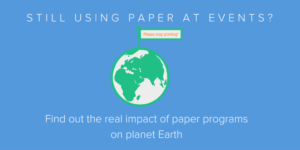As an event planner, your job is no longer just to make sure your event or conference goes off without a hitch. More and more, companies and guests expect you to implement sustainable strategies and reduce your event’s environmental impacts.
Why sustainable event planning matters
Conferences notoriously create significant environmental impact, even before and after the event itself. Consider the carbon footprint of all the guests’ travel and the waste produced during every meal and presentation.
An average event attendee generates 4.2 pounds of waste per day, according to MeetGreen. This means that a 3-day event with 1,000 attendees will generate 12,600 pounds of waste, 61% of which is landfill.
In this day and age of environmental awareness, more and more guests are reducing their environmental impact at home and expect efforts be made to do the same at the events they attend.
There is still great value and interest in gathering people in one place to exchange ideas and learn together, but you can take a more responsible approach in each part of the process to minimize the carbon load. With advance planning sustainable event planning can go from a goal to a reality.
Start Early
Making the switch to green event planning will mean more upfront research and preparation than before. So don’t wait.
The first step is the analysis: Take a deep dive into your event to better understand the environmental impacts and decide what you can change. There will be a number of opportunities for change including partnering with sustainable providers for catering, venue and waste management.
Keep in mind, it is likely going to take longer–and require more time to find–partners to help you meet your green event goals.
Your three big goals are to reduce waste, increase recycling, and reduce carbon footprints.
Location, Location, Location…and Transportation
While we cannot remove the necessity for travel to attend conferences and certain events, there are strategies to reduce CO2 emissions.
Start with the event location. While sunny Florida or an exotic location could be a draw for attendees, consider how far many of them would need to travel. According to myclimate.org, a flight from Chicago to Orlando will produce 0.68 metric tons of CO2 (about the same as 28 propane gas cylinders for barbecues), and a flight from Seattle about 1.5 metric tons (about 3.5 barrels of oil consumed).
By selecting more central locations for your events, or events that are in closer proximity to more of your attendees, you can help to reduce the overall carbon footprint of your event.
Also look at where the guests will stay once they’ve arrived for the conference. The optimal choice is to pick a venue within–or within comfortable walking distance–to the hotels where the bulk of attendees stay.
This is easier said than done for reasons that include too many people, hotels that aren’t large enough, and varying price points and budgets that mean that attendees will likely be staying in a number of different hotels. Don’t give up. Arrange group shuttles from the most popular hotels outside of walking distance to reduce the number of single passenger trips to and from the event.
Food and Beverage
The key to optimizing what you serve at your event is to consider the whole process for food and drink from production, location and shipping to preparation, serving and waste.
Where possible look for local caterers that source local food. By selecting food this way, you both help farms and businesses in the local economy and greatly reduce the overall carbon footprint of your event.
Food and its packaging create a massive amount of waste. But you can strategize to reduce waste. First and foremost, don’t order too much food. Having accurate numbers for attendees will help to determine how much food is going to be needed. If there still happens to be large amounts of food remaining, consider donating to local food banks, shelters or other nonprofits. You also would be helping the community. At the very least select a caterer with an active composting program.
Invest in Greener Containers
Styrofoam. Just don’t. The quickest, cheapest and easiest food containers and utensils are made from styrofoam and plastic, respectively. The problem is styrofoam and plastic take more than 500 years to biodegrade, if they ever do.
Adopt a reduce and recycle strategy. If it is not possible to take advantage of reusable dishes and utensils, look for biodegradable or wood alternatives. Fortunately there are many options to choose from.
Also be sure the venue has plenty of recycling containers available throughout. Wherever there is a trash can, ensure a recycling option is also present.
How Green Is Your Swag?
At this point, attendees expect welcome bags and swag, and many will throw much of it away when they get to their hotel. Consider putting vendor guidelines in place to steer the types of items being given at your event. Most promotional companies offer green alternatives.
Look at the items your event is providing also. Is there a better, greener alternative to the standard badge holder and lanyard? Perhaps offer an incentive for attendees to bring and reuse old ones? Take a look at everything you hand out and brainstorm or research an alternative.
Go Paperless
Making your event paperless is not only great for the environment, but it will also save your company money. Consider how much employee time, yours or your staff’s, is spent printing all those venue maps, schedules, and speaker bios?
Start by taking a look at all of the items that get printed for an event. There are sustainable alternatives for almost all of them.
Most venues are now equipped with screens that can be used for announcements, maps, sponsorship and more. Check with your venue to see what is available and put a plan in place to leverage the technology in place.
The biggest part of a paperless event is leading by example. Bring your event into the 21st century with your own mobile event app. By consolidating your event maps, speaker bios, agendas and more into a mobile event app, you can reduce paper use and bring a tech-forward spin to your event.
With Yapp, creating your own customized mobile event app has never been easier. Provide everything your attendees will need right at their fingertips.
To learn more about how to transition your event from print to mobile, download our free ebook.
The Bottom Line
Some aspects of going green have a very clear return on investment. For example, saving on paper printing costs, the costs of late corrections to printed materials, and the time and labor costs of distributing printed materials are pretty easy to calculate.
In other aspects, the bottom line of running a sustainable event is a little less clear, but no less important. Running a green event makes your attendees feel like they are part of a community of people that are forward-thinking, caring, and sophisticated. The bottom line of that may not be something we can calculate for you, but it’s hard to think of a more positive impact.



